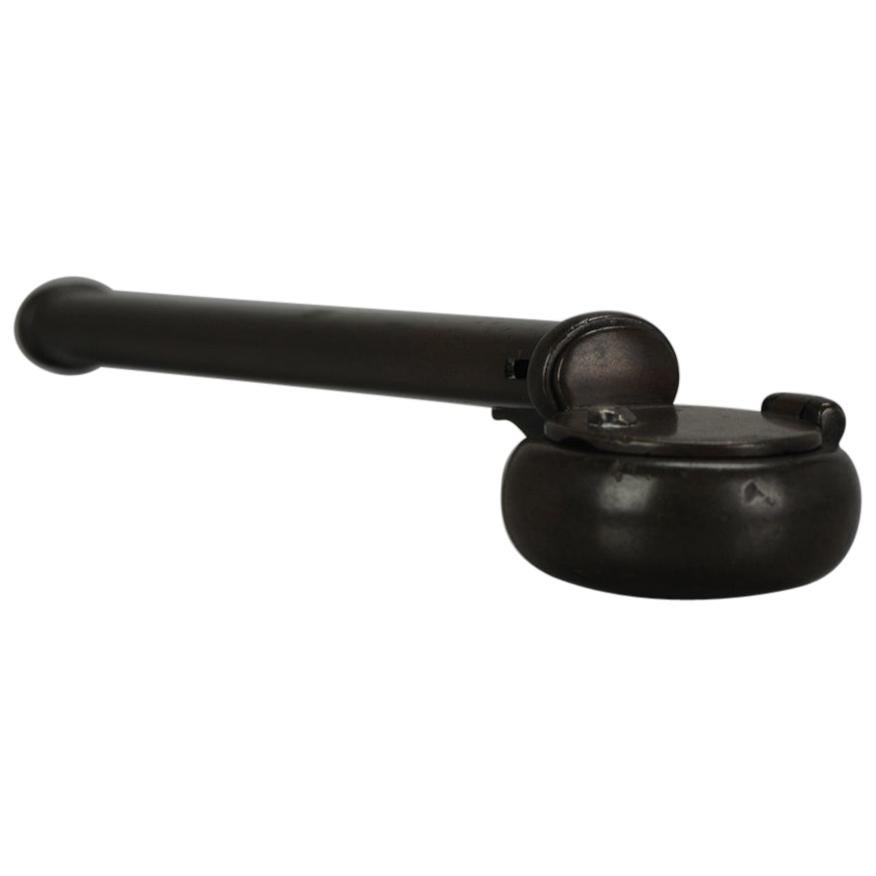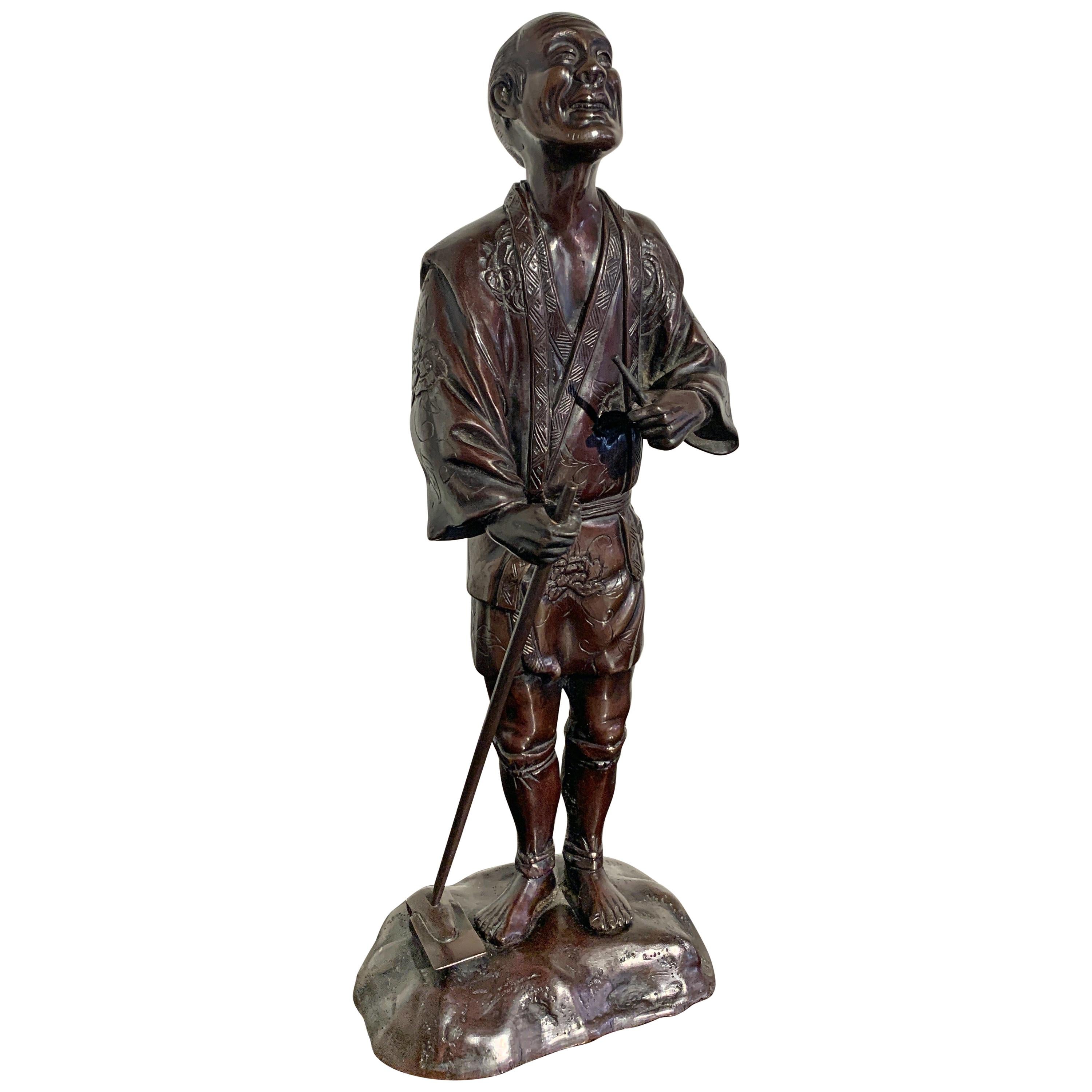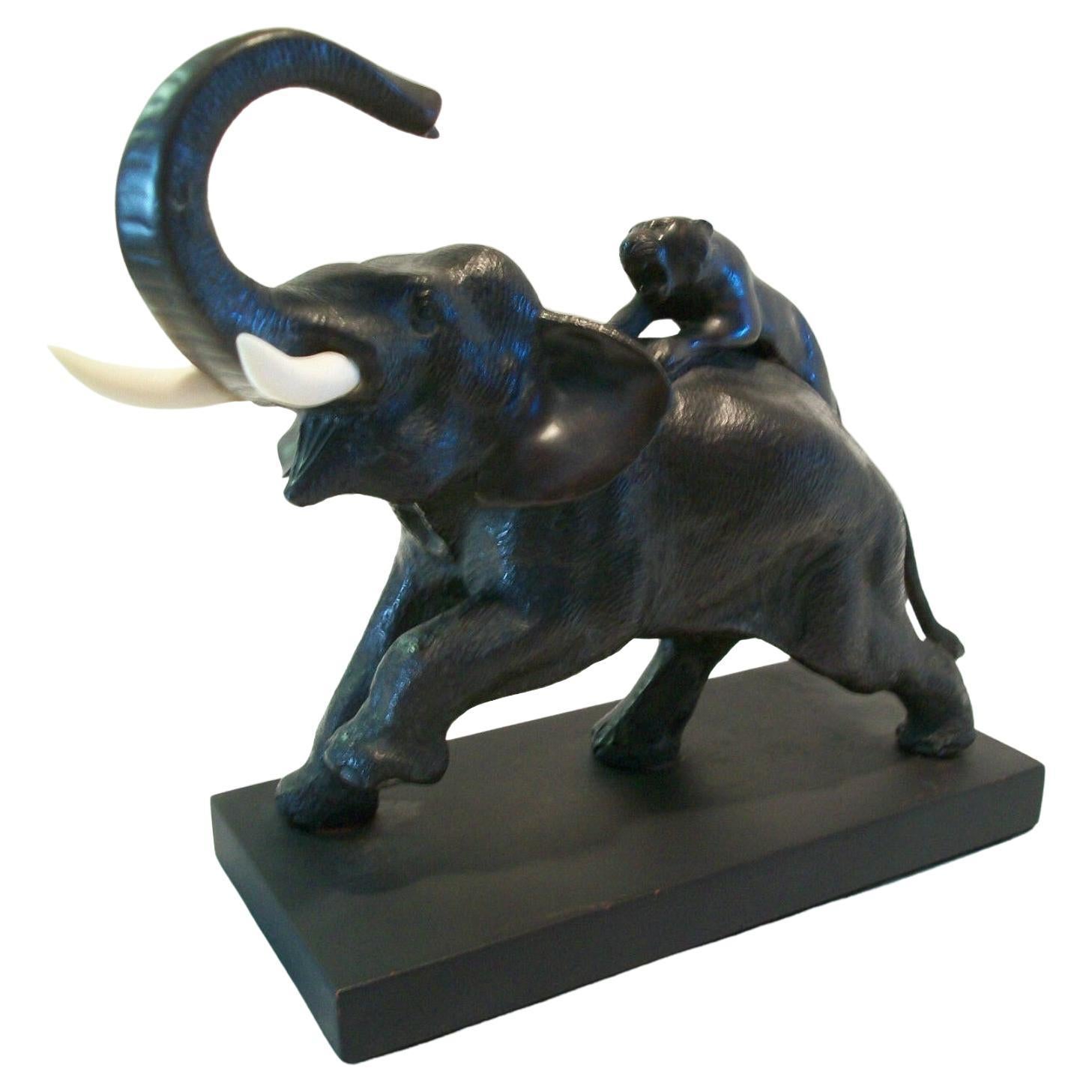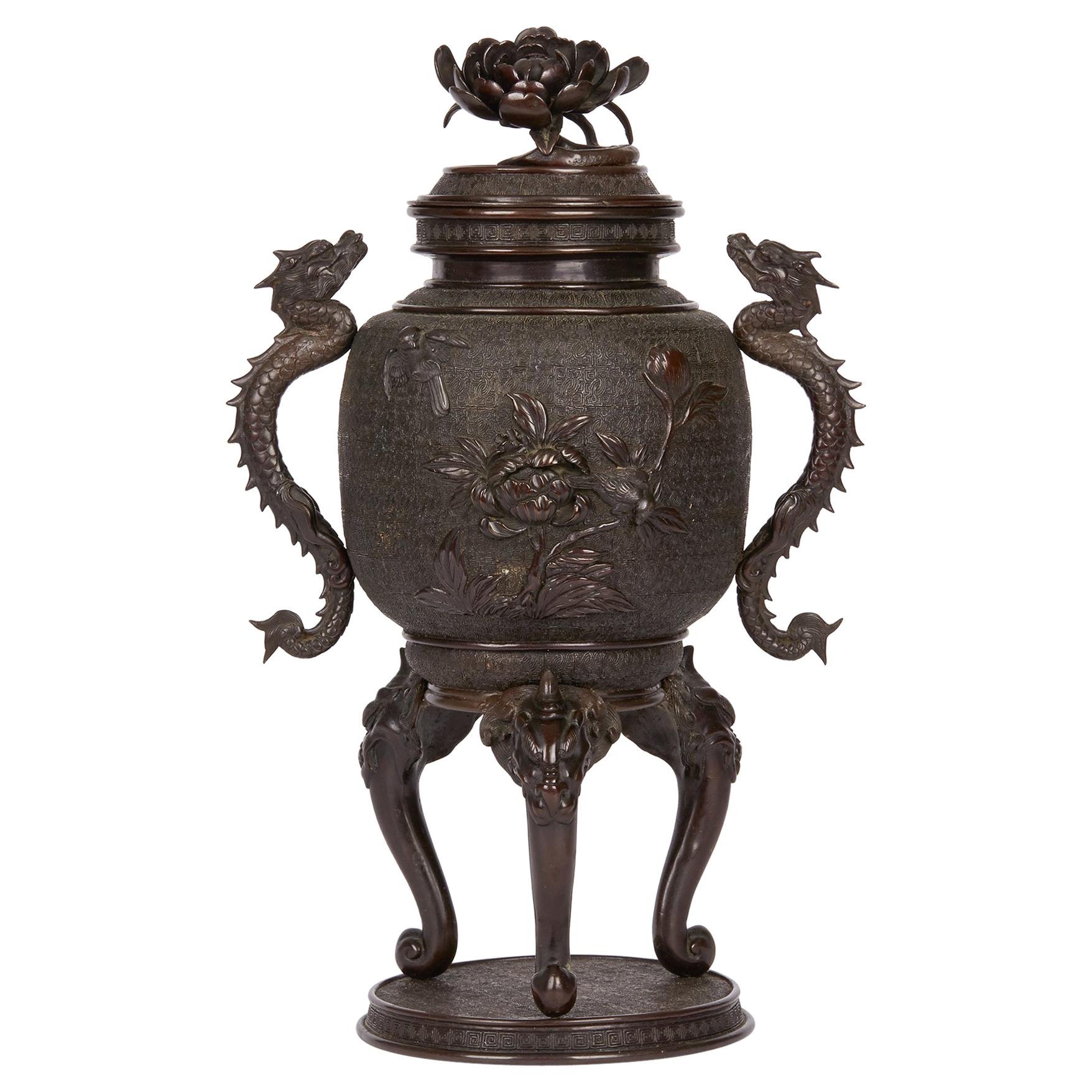Items Similar to Antique Bronze Meiji Okimono Inkpot of a Crab, 19th Century, Japan, Japanese
Want more images or videos?
Request additional images or videos from the seller
1 of 15
Antique Bronze Meiji Okimono Inkpot of a Crab, 19th Century, Japan, Japanese
About the Item
Nicely made artifact of a Crab in the use of an Inkpot.
Okimono (??, oki-mono) is a Japanese term meaning "ornament for display; objet d'art; decorative object", typically displayed in a tokonoma alcove or butsudan altar.
Crab
The crab is often used symbolically as the name sounds the same as ‘harmony, blend in’. There is an ancient legend that some ancient crabs were originally made of jade and has long been used as an aphrodisiac. The crab’s protective shell also means ‘first’ - it is the first heavenly stem and so expresses the wish to come first - particularly in examinations. So two crabs among rushes has the rather complex meaning for first place in the second class of examinations.
Condition
Overall condition no damages found. Weight 1418 grams. Size 225mm wide, 90mm high and145mm depth
Period
19th century Edo Period (1603–1867)
Meiji Periode (1867-1912).
- Dimensions:Height: 18.51 in (47 cm)Diameter: 16.93 in (43 cm)
- Materials and Techniques:
- Place of Origin:
- Period:
- Date of Manufacture:19th Century
- Condition:Wear consistent with age and use. Overall Condition No damages found. Weight 1418 grams. Size 225mm wide, 90mm high and145mm depth.
- Seller Location:Amsterdam, NL
- Reference Number:1stDibs: LU4863222945062
About the Seller
5.0
Gold Seller
These expertly vetted sellers are highly rated and consistently exceed customer expectations.
Established in 2015
1stDibs seller since 2019
158 sales on 1stDibs
Typical response time: 11 hours
- ShippingRetrieving quote...Ships From: Amsterdam, Netherlands
- Return PolicyA return for this item may be initiated within 14 days of delivery.
More From This SellerView All
- Antique Japanese Bronze Hatate 19th C Meiji Inkpot Japan UnsignedLocated in Amsterdam, Noord HollandLovely and very detailed piece. . If someone were to bring up the topic of Japanese antiques, what images would come to your mind? Kimono? Swords? Armor? Possibly netsuke? A few might even know what an inro is. How about the yatate? I have shown a yatate to many of my Japanese acquaintances here in Tokyo, and was surprised to discover that most did not even know what it was! Artists and calligraphers usually knew right away, though. A yatate (pronounced yah-tah-teh) is a Japanese portable writing set. The yatate has been around since the Kamakura period (1185-1333). It contains a traditional Japanese bamboo brush and an ink pot filled with cotton or silk which holds liquid sumi ink. Yatate literally means "arrow Stand." The Japanese traditional way of writing is with a brush (fude) and ink (sumi). Before the invention of the yatate, whenever anyone wanted to write or draw in ink, he had to make his own ink by grinding the ink stick...Category
Antique 19th Century Japanese Sculptures and Carvings
MaterialsBronze
- Antique Japanese Bronze Hatate 19th C Meiji Inkpot Japan UnsignedLocated in Amsterdam, Noord HollandLovely and very detailed piece. . If someone were to bring up the topic of Japanese antiques, what images would come to your mind? Kimono? Swords? Armor? Possibly netsuke? A few might even know what an inro is. How about the yatate? I have shown a yatate to many of my Japanese acquaintances here in Tokyo, and was surprised to discover that most did not even know what it was! Artists and calligraphers usually knew right away, though. nk stick, grinding stone and bamboo brushes A yatate (pronounced yah-tah-teh) is a Japanese portable writing...Category
Antique 19th Century Japanese Sculptures and Carvings
MaterialsBronze
- Antique Okimono Bronze Japanese Statue of a Crab 19th C Meiji JapanLocated in Amsterdam, Noord HollandNicely made artifact of high quality. Condition No damages, just some ware due to age. Size 180mm wide 110mm depth 50mm high Period 19th century 20th century Meiji Perio...Category
Antique 19th Century Japanese Meiji Ceramics
MaterialsBronze
- Antique Bronze Meiji Okimono of a Rat Japan, 19th CenturyLocated in Amsterdam, Noord HollandNicely made artifact/Okimono of a Rat. In bronze with brown patina, representing a rat. Okimono (置物, oki-mono) is a Japanese term meaning "ornament for display; objet d'art; decorat...Category
Antique 19th Century Japanese Meiji Animal Sculptures
MaterialsBronze
- Antique Meiji Period 19th Century Japanese Kobako Okimono Liu Hai TOadLocated in Amsterdam, Noord HollandThis is the most unusually made antique Kobako / Okimono we have had It shows Liu Hai the Alchemist with Chan Chu, the tree-legged toad who taught him the sec...Category
Antique 19th Century Japanese Qing Ceramics
MaterialsPorcelain
- Antique Bronze Vase Cloisonné Japan Meiji 19th Century JapaneseLocated in Amsterdam, Noord HollandAbsolute top Quality vase with superb decoration of flowers Cloisonné is a way of enamelling an object, (typically made of copper) whereby fine wires are used to delineate the dec...Category
Antique 19th Century Japanese Meiji Antiquities
MaterialsPorcelain
You May Also Like
- Japanese Tokyo School Bronze Okimono of a Farmer, Meiji PeriodLocated in Austin, TXA very fine and detailed Tokyo School cast bronze okimono (decorative sculpture) of a smiling farmer, Meiji period, late 19th century, Japan. The e...Category
Antique Late 19th Century Japanese Meiji Sculptures and Carvings
MaterialsBronze
- Antique Meiji Period Bronze & Bone Elephant Sculpture, Japan, 19th CenturyLocated in Chatham, ONAntique Meiji Period bronze and bone sculpture - dramatic fine casting of an elephant and tiger - mounted to an black painted wood base - unsigned -...Category
Antique Late 19th Century Japanese Meiji Sculptures and Carvings
MaterialsBronze
- Large Japanese Meiji Bronze Lidded Urn, 19th CenturyLocated in Bishop's Stortford, HertfordshireA large and stylish antique Japanese Meiji bronze lidded twin handle urn standing on a rounded plinth base with tongue and grotesque head formed legs with dragon handles and a flat c...Category
Early 20th Century Japanese Meiji Metalwork
MaterialsBronze
- Okimono - Bronze Sculpture By Kakuha Kanzaemon, Japan Meiji EraLocated in Saverne, Grand EstSuperb bronze okimono with black patina representing a peasant resting after his work, a basket of vegetables at his feet. Signed Kakuha Sei on the wooden stump. Excellent quality ! ...Category
Antique Late 19th Century Japanese Meiji Sculptures and Carvings
MaterialsBronze
- Pair of Japanese Cast Bronze Figures of Niō, Meiji Period, Late 19th CenturyLocated in Austin, TXA well cast pair of Japanese mixed metal okimono figures of Buddhist guardians, known as Nio or Dharmapala, protectors of Buddhist faith, Meiji Period, Japan. The smiling bronze g...Category
Antique Late 19th Century Japanese Meiji Sculptures and Carvings
MaterialsBronze
- Japanese Bronze Okimono of a Carp, Taisho Period, Early 20th Century, JapanLocated in Austin, TXAn elegant Japanese cast bronze okimono of a swimming carp, Taisho Period (1912 - 1926), early 20th century, Japan. The graceful fish portrayed realistically in motion, as if swimmi...Category
Vintage 1920s Japanese Taisho Sculptures and Carvings
MaterialsBronze
Recently Viewed
View AllMore Ways To Browse
Japan Bronze Sculpture
Japanese Bronze Sculpture
Ancient Japanese Furniture
Japanese Bronze Sculptures
Antique Japanese Carving
Antiques Shell Art
Ancient Asian Antiques
Antique Japanese Bronze Sculpture
Gold Altar
Japanese Meiji Carving
Japan Jade
Japanese Jade
Antique Alcove
Meiji Display
19th Century Shell Sculpture
Bronze Artifacts
Crab Gold
Meiji Bronze Sculpture





